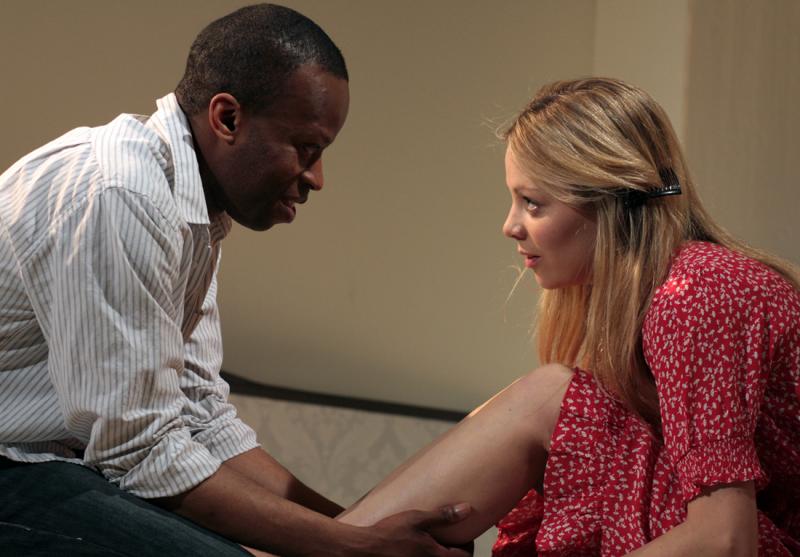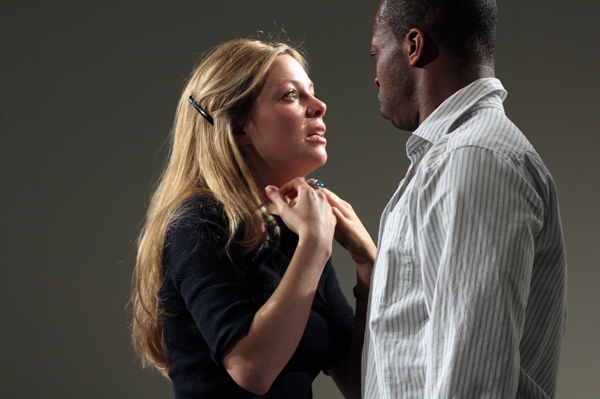The Girl in the Yellow Dress, Theatre 503 | reviews, news & interviews
The Girl in the Yellow Dress, Theatre 503
The Girl in the Yellow Dress, Theatre 503
Craig Higginson’s new two-hander is a sizzling and intelligent experience

Ethnic tensions in France have been in the news this week, with the siege of the gunman Mohammed Merah, so award-winning South-African penman Craig Higginson’s new play seems really timely. First seen in this country at the Salisbury Playhouse, and opening last night at Theatre 503 in south London, this story about the relationship between a French-Congolese student and an English teacher during a hot Parisian summer is full of emotion, and ideas.
Set in the chic flat of Celia, an attractive young teacher of English, this two-hander is a story about her encounter with Pierre, an equally young student who wants to learn this global language. At first this seems like a play about racial politics, but very soon it develops into something much more ambiguous and, in the end, disturbing. The warning signs are there early on: Pierre says that he has admired Celia from afar, and admits to following her. Is he a sinister stalker? Or is that just our racial stereotyping? And is she really so innocent?
Initial impressions are modified by fresh and very surprising revelations
As their relationship grows, both of them start telling each other stories from their different pasts. Once again, at first these seem to be the usual experiences of African horror and English dissatisfaction, but gradually such banal initial impressions are modified by fresh and very surprising revelations. As Celia says early on: “The actual facts are not always important. It’s how we present the facts that matters more. It’s not important that my story is half fantasy.”
Celia is, after all, a language teacher, and this is a play about language, communication and the relationship between truth and lies. Truth and fiction. Truth and fantasy. Throbbing through the dialogues is the idea of sexual desire as a disruptive force, an uncanny pulse that upsets expectations and tugs us to go down dark alleys and up crazy pathways. Higginson’s conception of the story contains a strong sexual charge, and more than just a hint of perversity. But who is really lying to whom?
This is also a drama about power relations, with a white teacher and black student, but it is also a play of ideas in which a proud and touchy black man confronts a neurotic and insecure white woman. There is a lot of psychological material about incestuous attraction, kleptomaniac tendencies and voyeuristic fixation. Metaphors are constantly being formed and then obscured by the grammar of the rather charming language lessons that make up the 90-minute play’s five scenes, each of which is named after a part of speech: the passive, narrative tenses, the conditional.
 This interest in language gives the play text a French sensibility, with its frank discussion of verbal meaning, its philosophical asides and its accounts of disappointments in desire. In this rendezvous, Anglo-Saxon politeness is a sheet of blank paper that is ripped up, scrunched up and thrown into a wastepaper bin. At times, it’s as if the text has taken a sip of very strong coffee, and it zips along with impressive zest and intelligence. At once an exploration of our darker sides and an acknowledgement that some experiences defy words, this is a thrilling, humorous and endlessly surprising piece.
This interest in language gives the play text a French sensibility, with its frank discussion of verbal meaning, its philosophical asides and its accounts of disappointments in desire. In this rendezvous, Anglo-Saxon politeness is a sheet of blank paper that is ripped up, scrunched up and thrown into a wastepaper bin. At times, it’s as if the text has taken a sip of very strong coffee, and it zips along with impressive zest and intelligence. At once an exploration of our darker sides and an acknowledgement that some experiences defy words, this is a thrilling, humorous and endlessly surprising piece.
Directed by Tim Roseman, one of the two artistic directors of this venue, on James Perkins’s evocative Eiffel Tower set, the drama is played with restraint, perhaps too much at times, and the literary formality of some of the text pulls the characters from the edge of madness. Fiona Button (from the BBC’s Lip Service) and Clifford Samuel are well matched (pictured above right), she rather petite and at first gently glowing while he is strong and seductive. But slowly his confidence is drained and her nerves are shredded. It’s erotic, exciting and thought-provoking.
The Girl in the Yellow Dress might originally have been written as a metaphor for the state of today’s South Africa, but it is also a metaphor in a much more universal sense: it’s about how we dare, or not, to face our darkest sides, and it’s as much about mutual guilt in relationships as it is about race relations. Either way, it’s brilliantly written and very well played. Once again, Theatre 503 has discovered a winning playwright, and a winner of a play.
rating
Buy
Explore topics
Share this article
The future of Arts Journalism
You can stop theartsdesk.com closing!
We urgently need financing to survive. Our fundraising drive has thus far raised £49,000 but we need to reach £100,000 or we will be forced to close. Please contribute here: https://gofund.me/c3f6033d
And if you can forward this information to anyone who might assist, we’d be grateful.

Subscribe to theartsdesk.com
Thank you for continuing to read our work on theartsdesk.com. For unlimited access to every article in its entirety, including our archive of more than 15,000 pieces, we're asking for £5 per month or £40 per year. We feel it's a very good deal, and hope you do too.
To take a subscription now simply click here.
And if you're looking for that extra gift for a friend or family member, why not treat them to a theartsdesk.com gift subscription?
more Theatre
 Wendy & Peter Pan, Barbican Theatre review - mixed bag of panto and comic play, turned up to 11
The RSC adaptation is aimed at children, though all will thrill to its spectacle
Wendy & Peter Pan, Barbican Theatre review - mixed bag of panto and comic play, turned up to 11
The RSC adaptation is aimed at children, though all will thrill to its spectacle
 Hedda, Orange Tree Theatre review - a monument reimagined, perhaps even improved
Scandinavian masterpiece transplanted into a London reeling from the ravages of war
Hedda, Orange Tree Theatre review - a monument reimagined, perhaps even improved
Scandinavian masterpiece transplanted into a London reeling from the ravages of war
 The Assembled Parties, Hampstead review - a rarity, a well-made play delivered straight
Witty but poignant tribute to the strength of family ties as all around disintegrates
The Assembled Parties, Hampstead review - a rarity, a well-made play delivered straight
Witty but poignant tribute to the strength of family ties as all around disintegrates
 Mary Page Marlowe, Old Vic review - a starry portrait of a splintered life
Tracy Letts's Off Broadway play makes a shimmeringly powerful London debut
Mary Page Marlowe, Old Vic review - a starry portrait of a splintered life
Tracy Letts's Off Broadway play makes a shimmeringly powerful London debut
 Little Brother, Soho Theatre review - light, bright but emotionally true
This Verity Bargate Award-winning dramedy is entertaining as well as thought provoking
Little Brother, Soho Theatre review - light, bright but emotionally true
This Verity Bargate Award-winning dramedy is entertaining as well as thought provoking
 The Unbelievers, Royal Court Theatre - grimly compelling, powerfully performed
Nick Payne's new play is amongst his best
The Unbelievers, Royal Court Theatre - grimly compelling, powerfully performed
Nick Payne's new play is amongst his best
 The Maids, Donmar Warehouse review - vibrant cast lost in a spectacular-looking fever dream
Kip Williams revises Genet, with little gained in the update except eye-popping visuals
The Maids, Donmar Warehouse review - vibrant cast lost in a spectacular-looking fever dream
Kip Williams revises Genet, with little gained in the update except eye-popping visuals
 Ragdoll, Jermyn Street Theatre review - compelling and emotionally truthful
Katherine Moar returns with a Patty Hearst-inspired follow up to her debut hit 'Farm Hall'
Ragdoll, Jermyn Street Theatre review - compelling and emotionally truthful
Katherine Moar returns with a Patty Hearst-inspired follow up to her debut hit 'Farm Hall'
 Troilus and Cressida, Globe Theatre review - a 'problem play' with added problems
Raucous and carnivalesque, but also ugly and incomprehensible
Troilus and Cressida, Globe Theatre review - a 'problem play' with added problems
Raucous and carnivalesque, but also ugly and incomprehensible
 Clarkston, Trafalgar Theatre review - two lads on a road to nowhere
Netflix star, Joe Locke, is the selling point of a production that needs one
Clarkston, Trafalgar Theatre review - two lads on a road to nowhere
Netflix star, Joe Locke, is the selling point of a production that needs one
 Ghost Stories, Peacock Theatre review - spirited staging but short on scares
Impressive spectacle saves an ageing show in an unsuitable venue
Ghost Stories, Peacock Theatre review - spirited staging but short on scares
Impressive spectacle saves an ageing show in an unsuitable venue
 Hamlet, National Theatre review - turning tragedy to comedy is no joke
Hiran Abeyeskera’s childlike prince falls flat in a mixed production
Hamlet, National Theatre review - turning tragedy to comedy is no joke
Hiran Abeyeskera’s childlike prince falls flat in a mixed production

Add comment